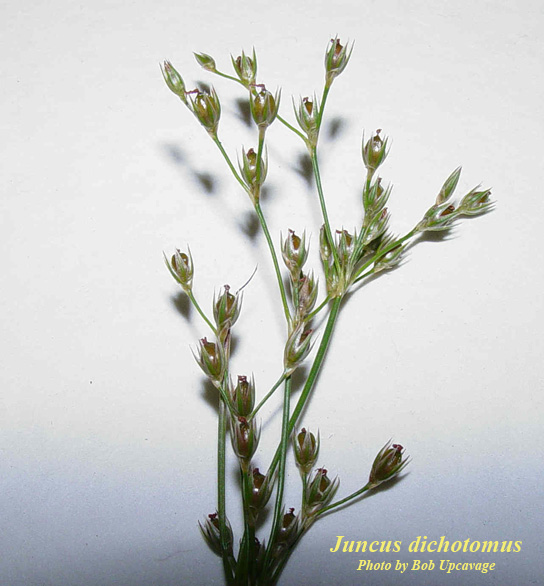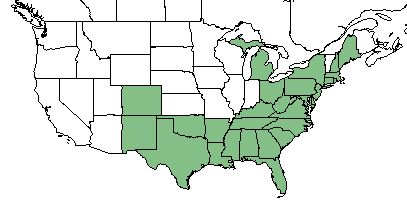Difference between revisions of "Juncus dichotomus"
(→Description) |
(→Ecology) |
||
| (9 intermediate revisions by 4 users not shown) | |||
| Line 1: | Line 1: | ||
{{italic title}} | {{italic title}} | ||
| + | Common names: forked rush <ref name= "USDA"> [https://plants.usda.gov/core/profile?symbol=CEAM USDA Plant Database]</ref> | ||
<!-- Get the taxonomy information from the NRCS Plants database --> | <!-- Get the taxonomy information from the NRCS Plants database --> | ||
{{taxobox | {{taxobox | ||
| Line 27: | Line 28: | ||
==Distribution== | ==Distribution== | ||
| + | ''J. dichotomus'' is found in the southern United States and much of the east coast; specifically Florida, Georgia, South Carolina, North Carolina, Virginia, West Virginia, Maryland, New Jersey, Pennsylvania, New York, Connecticut, Massachusetts, Vermont, Maine, Rhode Island, Ohio, Kentucky, Indiana, Tennessee, Michigan, Mississippi, Louisiana, Texas, Arkansas, Oklahoma, New Mexico, and Colorado.<ref name= "USDA"> [https://plants.usda.gov/core/profile?symbol=CEAM USDA Plant Database]</ref> | ||
| + | |||
==Ecology== | ==Ecology== | ||
| − | ===Habitat=== <!--Natural communities, human disturbed habitats, topography, hydrology, soils, light, fire regime requirements for removal of competition, etc.--> | + | ===Habitat=== |
| − | + | ''J. dichotomus'' is often found in disturbed areas such as wet ditches and meadows. <ref name= "Weakley"> Weakley, A. S. (2015). Flora of the Southern and Mid-Atlantic States. Chapel Hill, NC, University of North Carolina Herbarium.</ref> Other habitats that specimens have been colelcted from include dry loamy sands, and wet ditches in pine flatwoods. <ref name = "FSU herbarium"> URL: http://herbarium.bio.fsu.edu. Last accessed: June 2018. Collectors: Ed Keppner, Lisa Keppner, Loran Anderson, R.K. Godfrey, R.F. Doren, Andre F. Clewell, Alush Shilom Ton, Garrett Crow, Walter Judd, Richard Carter. States and counties: Florida (Bay, Wakulla, Gadsden, Washington, Leon, Franklin, Alachua) Georgia (Ben Hill, Thomas)</ref> ''J. dichotomus'' has shown regrowth in reestablished longleaf woodlands that were disturbed by agriculture in South Carolina, making it an indicator species for post-agricultural woodlands.<ref>Brudvig, L.A., E Grman, C.W. Habeck, and J.A. Ledvina. (2013). Strong legacy of agricultural land use on soils and understory plant communities in longleaf pine woodlands. Forest Ecology and Management 310: 944-955.</ref> ''J. dichotomus'' is not tolerant of drought but has a high fire tolerance. <ref name= "USDA"> [https://plants.usda.gov/core/profile?symbol=CEAM USDA Plant Database]</ref> | |
| + | <!--Natural communities, human disturbed habitats, topography, hydrology, soils, light, fire regime requirements for removal of competition, etc.--> | ||
| + | |||
| + | ===Phenology=== | ||
| + | ''J. dichotomus'' has been observed to flower in April. <ref name= "Pan Flora"> Nelson, G. PanFlora: Plant data for the eastern United States with emphasis on the Southeastern Coastal Plains, Florida, and the Florida Panhandle. www.gilnelson.com/PanFlora/ Accessed: 22 MAY 2018</ref> | ||
| + | |||
| + | Seed dispersal begins in summer. <ref name= "USDA"> [https://plants.usda.gov/core/profile?symbol=CEAM USDA Plant Database]</ref> | ||
| + | <!--Timing off flowering, fruiting, seed dispersal, and environmental triggers. Cite PanFlora website if appropriate: http://www.gilnelson.com/PanFlora/ --> | ||
<!--===Seed dispersal===--> | <!--===Seed dispersal===--> | ||
<!--===Seed bank and germination===--> | <!--===Seed bank and germination===--> | ||
| − | + | ||
| − | + | ===Fire ecology=== | |
| − | + | ''J. dichotomus'' is not fire resistant. <ref name= "USDA"> [https://plants.usda.gov/core/profile?symbol=CEAM USDA Plant Database]</ref> | |
| + | <!--Fire tolerance, fire dependence, adaptive fire responses--> | ||
| + | ===Pollination and use by animals=== | ||
| + | ''J. dichotomus'' is not used by animals for grazing or browse. <ref name= "USDA"> [https://plants.usda.gov/core/profile?symbol=CEAM USDA Plant Database]</ref> | ||
| + | <!--Herbivory, granivory, insect hosting, etc.--> | ||
<!--==Diseases and parasites==--> | <!--==Diseases and parasites==--> | ||
Latest revision as of 15:48, 23 June 2021
Common names: forked rush [1]
| Juncus dichotomus | |
|---|---|

| |
| Photo by the Atlas of Florida Plants Database | |
| Scientific classification | |
| Kingdom: | Plantae |
| Division: | Magnoliophyta - Flowering plants |
| Class: | Liliopsida - Moncots |
| Order: | Juncales |
| Family: | Juncaceae |
| Genus: | Juncus |
| Species: | J. dichotomus |
| Binomial name | |
| Juncus dichotomus Ell. | |

| |
| Natural range of Juncus dichotomus from USDA NRCS Plants Database. | |
Contents
Taxonomic Notes
Synonyms: J. dichotomus var. platyphyllus (Wiegand)
Variety: none
Description
J. dichotomus is a perennial graminoid of the Juncaceae family that is native to North America. [1]
Distribution
J. dichotomus is found in the southern United States and much of the east coast; specifically Florida, Georgia, South Carolina, North Carolina, Virginia, West Virginia, Maryland, New Jersey, Pennsylvania, New York, Connecticut, Massachusetts, Vermont, Maine, Rhode Island, Ohio, Kentucky, Indiana, Tennessee, Michigan, Mississippi, Louisiana, Texas, Arkansas, Oklahoma, New Mexico, and Colorado.[1]
Ecology
Habitat
J. dichotomus is often found in disturbed areas such as wet ditches and meadows. [2] Other habitats that specimens have been colelcted from include dry loamy sands, and wet ditches in pine flatwoods. [3] J. dichotomus has shown regrowth in reestablished longleaf woodlands that were disturbed by agriculture in South Carolina, making it an indicator species for post-agricultural woodlands.[4] J. dichotomus is not tolerant of drought but has a high fire tolerance. [1]
Phenology
J. dichotomus has been observed to flower in April. [5]
Seed dispersal begins in summer. [1]
Fire ecology
J. dichotomus is not fire resistant. [1]
Pollination and use by animals
J. dichotomus is not used by animals for grazing or browse. [1]
Conservation and Management
Cultivation and restoration
Photo Gallery
References and notes
- ↑ 1.0 1.1 1.2 1.3 1.4 1.5 1.6 USDA Plant Database
- ↑ Weakley, A. S. (2015). Flora of the Southern and Mid-Atlantic States. Chapel Hill, NC, University of North Carolina Herbarium.
- ↑ URL: http://herbarium.bio.fsu.edu. Last accessed: June 2018. Collectors: Ed Keppner, Lisa Keppner, Loran Anderson, R.K. Godfrey, R.F. Doren, Andre F. Clewell, Alush Shilom Ton, Garrett Crow, Walter Judd, Richard Carter. States and counties: Florida (Bay, Wakulla, Gadsden, Washington, Leon, Franklin, Alachua) Georgia (Ben Hill, Thomas)
- ↑ Brudvig, L.A., E Grman, C.W. Habeck, and J.A. Ledvina. (2013). Strong legacy of agricultural land use on soils and understory plant communities in longleaf pine woodlands. Forest Ecology and Management 310: 944-955.
- ↑ Nelson, G. PanFlora: Plant data for the eastern United States with emphasis on the Southeastern Coastal Plains, Florida, and the Florida Panhandle. www.gilnelson.com/PanFlora/ Accessed: 22 MAY 2018